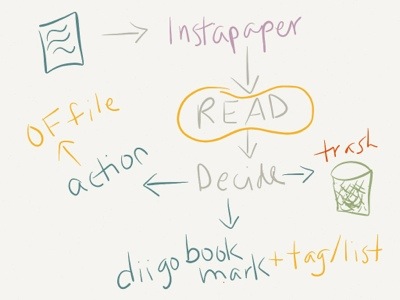July 14th, 2012 | Filed under: teacher productivity
Thinking a lot about how I read and, more importantly, how I act on what I read online. Also playing with the paper app for iPad in sketching out this workflow. I save many things to Instapaper, but not all of that gets read. Sometimes I log into my Instapaper queue and realize something isn’t relevant to me anymore, so it gets trashed. Otherwise I follow this workflow:

Basically I read or scan the link and do one of the following things: create an action item related to the reading in Omnifocus, save and tag the link in diigo, or trash it. I am working on doing more trashing than saving, because I want my diigo library to be useful and not a catch-all for links.
I’m toying with throwing Evernote into this mix if it’s something that might work for a specific unit or lesson, but still not sure if that’s helpful or “just another thing.”
Tags: diigo, gtd, Instapaper, omnifocus, productivity, workflow project 1 Comment »
March 11th, 2009 | Filed under: personal, technology
So, I’ve been using del.icio.us for quite a while now to track my bookmarks. If you’re unfamiliar with social bookmarking, here’s a good explanation by Common Craft. But basically it’s a Web-based way to track you bookmarks and share them with others if you want (you have the option to keep them private as well).
Del.icio.us has worked really well for me so far. You can tag each bookmark, make notes and search within the bookmarks. Most of mine deal with crafts, vegan cooking and education stuff. You can check out my bookmarks here.
But…something better came along.
Diigo is just like del.icio.us, but with some awesome extras, my favorite being the ability to highlight parts of a Web page and make annotations within it. This solves my need for an online notebooking service. Google is doing away with its Notebook, which I loved, and I’ve been searching for a good one ever since. I’ve been testing Zotero, but haven’t enjoyed it as much. With Diigo I can highlight the parts of the page I like or plan on using in a paper, for example, and make notes of where I want to use it.
And there’s a social part of all this, of course. You can add friends on Diigo, see their bookmarks and see the annotations of every other Diigo user that has made their bookmarks public. So, for example, if I make a note on a page, you can check out the same page and tell Diigo to show you my notes. And you can make your own notes – or even respond to mine!
Another feature I like is the ability to mark a page or article as “read later.” Often, with del.icio.us, I would tag an article and plan to go back later, but I’d never get around to it. Out of sight, out of mind. With the Diigo toolbar, I’m reminded of the articles I need to check out. It’s a small thing, but I like it.
The biggest thing that sold me on Diigo was that I didn’t have to leave del.icio.us. I uploaded my del.icio.us bookmarks to Diigo and can request Diigo to post my bookmarks and tags to del.icio.us concurrently using the “save elsewhere” feature. Seriously!
There has been a lot of discussion on Twitter and forums about moving to Diigo and I decided to go for it. I’m loving it so far and I’m sure there are great features I haven’t used yet. This article really sold me on the reasons to switch.
Here I am on Diigo – let’s be friends!
Tags: bookmarking, delicious, diigo, Google Notebook, social bookmarking, technology, Twitter, zotero No Comments »

